

The Chemistry of Dienes and Polyenes. Volume 1
Edited by Zvi Rappoport
Copyright ∂ 1997 John Wiley & Sons, Ltd.
ISBN: 0-471-96512-X
CHAPTER 21
Synthesis and transformation of radialenes
GERHARD MAAS
Abteilung Organische Chemie I, University of Ulm, Albert-Einstein-Allee 11, D-89069 Ulm, Germany
Fax: (internat.)+49(0)731-502-2803; e-mail: gerhard.maas@chemie.uni-ulm.de
and
HENNING HOPF
Institut fur¨ Organische Chemie, Technical University of Braunschweig, Hagenring 30, D-38106 Braunschweig, Germany
Fax: (internat.)+49(0)531-391-5388; e-mail: H.Hopf@tu-bs.de
I. INTRODUCTION . . . . . . . . . . . . . . . . . . . . . . . . . . . . . . . . . . . . . . |
927 |
A. Nomenclature and Classification . . . . . . . . . . . . . . . . . . . . . . . . . . |
927 |
B. Significance of the Radialenes . . . . . . . . . . . . . . . . . . . . . . . . . . . . |
930 |
C. Scope of the Review . . . . . . . . . . . . . . . . . . . . . . . . . . . . . . . . . . |
930 |
II. SYNTHESIS AND TRANSFORMATION OF RADIALENES . . . . . . . . . |
931 |
A. [3]Radialenes . . . . . . . . . . . . . . . . . . . . . . . . . . . . . . . . . . . . . . . |
931 |
B. [4]Radialenes . . . . . . . . . . . . . . . . . . . . . . . . . . . . . . . . . . . . . . . |
945 |
C. [5]Radialenes . . . . . . . . . . . . . . . . . . . . . . . . . . . . . . . . . . . . . . . |
961 |
D. [6]Radialenes . . . . . . . . . . . . . . . . . . . . . . . . . . . . . . . . . . . . . . . |
964 |
E. Higher Radialenes . . . . . . . . . . . . . . . . . . . . . . . . . . . . . . . . . . . . |
970 |
III. CONCLUDING REMARKS . . . . . . . . . . . . . . . . . . . . . . . . . . . . . . . |
974 |
IV. ACKNOWLEDGMENTS . . . . . . . . . . . . . . . . . . . . . . . . . . . . . . . . . |
974 |
V. REFERENCES . . . . . . . . . . . . . . . . . . . . . . . . . . . . . . . . . . . . . . . . |
974 |
I.INTRODUCTION
A.Nomenclature and Classification
Radialenes are alicyclic compounds in which all ring carbon atoms are sp2-hybridized and carry as many exocyclic double bonds as possible. The general term for the parent
927

928 |
Gerhard Maas and Henning Hopf |
molecules is [n]radialenes where n 3 and stands both for the ring size and the number of double bonds involved. Thus the hydrocarbons 1 4, with the general formula CnHn (n D 3,4,5,6) are [3]-, [4]-, [5]-, and [6]radialene.
(1) |
(2) |
(3) |
(4) |
It is obvious that these compounds have in common an uninterrupted cyclic arrangement of cross-conjugated -systems. Compound 5 likewise contains the maximum number of exocyclic double bonds at a perimeter consisting only of sp2-hybridized carbon atoms. Thus, our definition allows one to call it a radialene, i.e. naphtharadialene; on the other hand, it excludes hydrocarbons such as 6 [3,4,5,6-tetrakis(methylene)cyclohexene]. Although in the latter molecule all carbon atoms are indeed sp2-hybridized, the number of exocyclic double bonds has not reached its maximum. In 5, however, the number of double bonds cannot be increased further.
(5) |
(6) |
It is of course possible to name individual radialenes according to IUPAC rules [e.g. per(methylene)cycloalkanes 1 4]. However, the descriptiveness of the term ‘radialene’ may some day pave its way into the ‘official’ nomenclature. For substituted [n]radialenes we have proposed1 a ‘pragmatic’ numbering system, in which an ‘inner ring’ is numbered first, followed by an ‘outer ring’. The numbering of substituents should follow IUPAC rules. Thus, the hydrocarbon 7 is 4,4-diethyl-5,5-dimethyl[3]radialene, the ester 8 should be called 7-methoxycarbonyl-5,5-dimethyl[4]radialene, the nitrile 9 which can exist in four diastereomeric forms is (6Z,7Z)-6-cyano-5,5,7-trimethyl[4]radialene and the difunctionalized [5]radialene 10 is (7E,6Z)-7-bromo-6-formyl-6-methyl[5]radialene.
|
|
|
|
|
|
|
|
|
Br |
7 |
|
|
|
|
|
|
|
|
|
|
|
|
|
|
4 |
|
6 |
7 |
7 |
|
6 |
|
|
|
CHO |
|
|
|
|
|
|
8 |
2 |
|
6 |
||
|
1 |
|
2 |
3 |
CO2 Me |
|
CN |
|
|||
|
|
|
|
|
3 |
1 |
Me |
||||
|
|
|
3 |
2 |
|
||||||
|
3 |
|
1 |
4 |
|
|
4 |
5 |
|
||
|
|
|
4 |
1 |
|
|
|||||
|
|
|
|
|
|
|
|||||
6 |
2 |
5 |
5 |
8 |
8 |
|
|
|
|
|
|
|
|
5 |
|
9 |
|
10 |
|||||
|
|
|
|
|
|
|
|
||||
|
(7) |
|
(8) |
|
(9) |
|
(10) |
|
|||
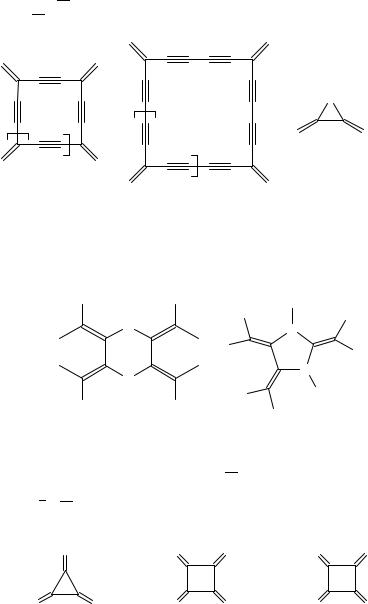
21. Synthesis and transformation of radialenes |
929 |
We are aware that these simple rules must and will be extended as the structural complexity of the known radialenes evolves. Unfortunately, however, the ‘catchiness’ of the term radialene has led to its inflationary use in recent years. Although we think it is justified to call molecules such as 11 and 12 ‘expanded’ [4]- (n D 1) and [6]radialenes (n D 3) by widening our above definition, since sp-hybridized carbon atoms are ‘allowed’ we hesitate to call compounds of the type 13 heteroradialenes.
|
|
X |
n |
X = |
SiR2 , NH, PH, S, ... |
|
n |
|
(11) |
(12) |
(13) |
If one were to call compounds 13 radialenes, one would have to include molecules such as 14 and 15 as well. Although this has been done in the chemical literature we prefer to regard these latter unsaturated ring systems as polyalkylidene heterocycles. One reason for this is that they are lacking the characteristic cross-conjugation encountered in the radialenes (see above).
NMe2
X B
B
X
NMe2
X = SiR2 , SnR2 , BR
(14) |
(15) |
On the other hand, radialenes whose methylene groups have been replaced partially or totally by heteroatoms or heteroorganic groups as examples, the (unknown) ‘oxocarbons’ 16 and 17 may be quoted as well as the tetraaza[4]radialene 18 and ‘mixed’ systems such as 19 21 are clearly covered by the above definition if ‘sp2-hybridized carbon atom’ is replaced by the appropriate isovalent group. Such heteroradialenes, however, will
|
O |
O |
O |
RN |
NR |
O |
O |
O |
O |
RN |
NR |
|
(16) |
|
(17) |
|
(18) |
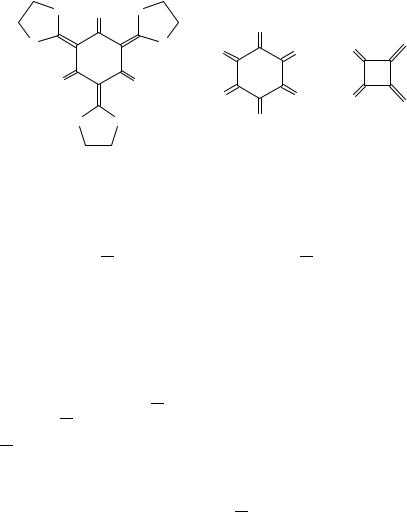
930 |
|
Gerhard Maas and Henning Hopf |
|
||
S |
O |
S |
|
|
|
|
|
|
O |
|
|
S |
|
S |
N2 |
N2 |
RP |
|
|
|
|
||
O |
|
O |
|
|
|
|
|
|
O |
O |
RP |
|
|
|
|
|
|
S |
S |
|
N2 |
|
|
|
(19) |
|
(20) |
|
(21) |
not be presented here in detail, since this volume deals with the chemistry of CDC double bond systems.
B. Significance of the Radialenes
Among the olefins and unsaturated systems in general the radialenes were the last to attract the interest of the chemists. Although the number of publications dealing with these cross-conjugated molecules has been growing rapidly during the last decade, they still cannot compete in importance with many of the other classes of dienic and polyenic -systems discussed in this Volume. In fact, it appears likely that they will always play a specialized role among the numerous unsaturated hydrocarbon systems and their derivatives. However, many of the reactions employed to prepare the radialenes are useful in other fields of synthetic chemistry, the structural data obtained are of importance in comparsion to those of other -structures, and for the development of computational methods the radialenes are also important reference structures. The radialenes are hence not only of importance for their own sake.
The last review on radialenes which is also the first ever published and still the only available one was published by the authors just a few years ago1. This, of course, raises the question of whether the present summary is really necessary. We believe it is not only for the sake of completeness but also since especially during the last fiveyear period there has been significant progress in the radialene area. The main reason for this lies outside of radialene chemistry and has to do with the development of fullerene chemistry on the one hand, and various attempts to synthesize novel carbon allotropes and networks on the other. For example, C60 may be regarded as a cyclic dodecamer of (the still unknown) [5]radialene hydrocarbon the six-membered ring of the former being produced ‘automatically’ when the hydrogen atoms of the latter are ‘removed’ (on paper). Correspondingly, partial structures of C60 containing five-membered rings may be regarded as derivatives of [5]radialene also. The so-called ‘exploded’ radialenes (see below) are other examples of the extension of a basic radialene structural element to a larger molecular framework or scaffold.
C. Scope of the Review
Since our earlier review1 appeared not so long ago, it makes no sense to repeat here all facets of the radialene family. Therefore, we focus here on the synthesis and chemical transformation of the radialenes, and we suggest the reader consult our earlier review for information on structural and spectroscopic data as well as the use of radialenes as building blocks for organic conductors and organic ferromagnets, as these topics will not
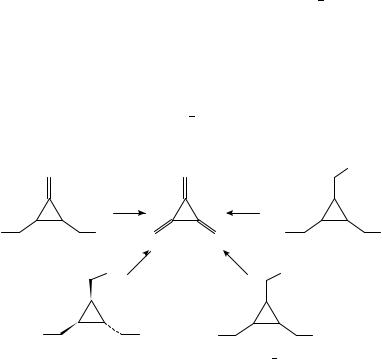
21. Synthesis and transformation of radialenes |
931 |
be discussed in this chapter any more. We have tried to include in the present review the material published in the primary literature until the end of 1995. Besides using our own literature files we carried out both a Chemical Abstract and Beilstein CrossfireTM literature search.
II.SYNTHESIS AND TRANSFORMATION OF RADIALENES A. [3]Radialenes
The parent [3]radialene 1 has been generated from variously functionalized cyclopropane precursors by classical ˇ-elimination reactions (Scheme 1)2 6. All these reactions have been carried out as gas-phase reactions, and the radialene has been collected at63 °C or below. At 78 °C, the pure compound is stable for several days, but polymerization occurs when the vapor is exposed to room temperature as well as in carbon tetrachloride at 273 K2, or in contact with oxygen3.
Attempts to prepare 1 from some other precursors were largely unsuccessful: N, N0 , N00 -(cyclopropane-1,2,3-trimethyl)-tris(dimethylamine oxide) decomposed unspecifically above 250 °C3 and pyrolysis of 1,2,3-tris(acetoxymethyl)cyclopropane gave mainly benzene3; its gas-phase pyrolysis at 570 580 °C produced a mixture of at least fifteen compounds containing perhaps a small amount of 17.
+
NMe3
a |
b |
− |
3 OH
|
|
+ |
+ |
Br |
Br |
Me3 N |
NMe3 |
|
|
(1) |
|
|
c |
d |
|
|
Ι |
Br |
|
I |
I |
Br |
Br |
SCHEME 1. Reagents: (a) KOH, 150 °C, 47% yield2; (b) 160 170 °C, 4.5 Torr, 1.5% yield3,4;
(c) KOH, 140 °C, ca 20% yield3,4; (d) powdered KOH, CaO, 150 °C, 1 Torr, no yield given5,6
Various alkyland aryl-substituted [3]radialenes could be prepared from 1,1-dihaloal- kenes using organometallic pathways. Hexamethyl-[3]radialene (25), the first [3]radialene to be synthesized, was obtained in a very low yield by treatment of 1,1-dibromo-2-methyl- 1-propene (22) with butyllithium8,9. The lithium carbenoid 23 and the butatriene 24 are likely intermediates of this transformation (Scheme 2), the former being the source of an unsaturated carbene moiety which is transferred onto the latter. However, the outer double bonds of 24 are more readily cyclopropanated than the central one.
It appears that neither the lithium carbenoid pathway nor the cyclopropanation of butatrienes are general routes to [3]radialenes. More successful is the cyclotrimerization of 1,1-dihaloalkenes via copper or nickel carbenoids, provided the substituents at the other end of the CDC double bond are not too small. Thus, tris(fluoren-9-ylidene)cyclopropane 27 was formed besides butatriene 28 from the (1-bromo-1-alkenyl)cuprate 26 generated in situ from (9-dibromomethylene)fluorene (Scheme 3)10. The cuprate complexes formed
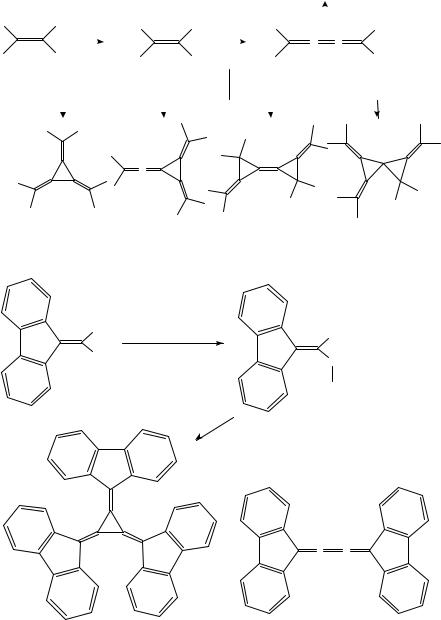
932 |
|
|
|
|
|
Gerhard Maas and Henning Hopf |
|
|
|
|
|||||
|
|
|
|
|
|
|
|
|
|
|
polymerization |
||||
|
|
|
|
|
|
|
|
|
|
|
on contact with O2 |
||||
Me |
Br |
|
|
|
Me |
|
Br |
|
|
|
|
|
|
|
|
|
|
|
|
|
Me |
|
Me |
||||||||
|
|
|
|
|
|
|
|
|
|||||||
Me |
Br |
a |
|
|
|
|
|
|
C |
|
C |
||||
|
|
|
|
|
|
|
|
|
|||||||
|
|
|
|
|
|
|
|||||||||
|
|
|
Me |
|
Li |
|
Me |
|
Me |
||||||
(22) |
|
|
|
|
|
|
(23) |
|
|
|
(24) |
|
|
||
|
|
|
|
|
|
|
|
|
|
|
|||||
|
|
|
|
|
|
|
|
|
|
|
|
|
|
|
|
|
|
|
|
|
|
|
|
|
|
|
|
|
|
|
|
C
(25) 0.3−2 %
SCHEME 2. Reagents: (a) 2 equiv. of 22; 1. BuLi (1.25 equiv.), THF, 110 °C; 2. 110 °C ! 65 °C; 3. BuLi (0.75 equiv.), 65 °C ! 20 °C
Br |
1. BuLi, THF, < − 90 °C |
Br |
|
2. CuSPh |
|||
|
Br
CuSPh
Li
(26)
THF, 20 °C
+ |
• |
• |
(27) 22% |
(28) 58% |
SCHEME 3
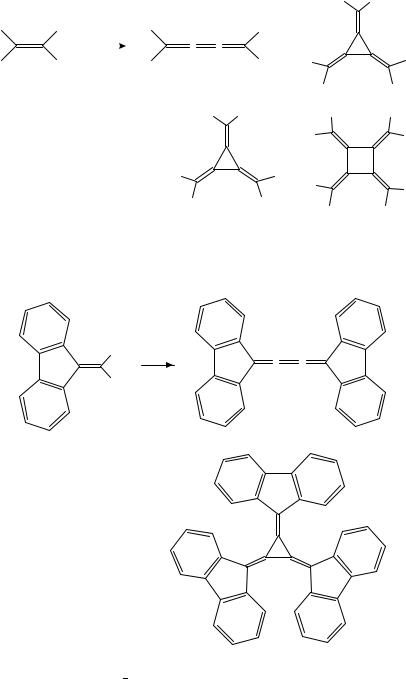
|
|
21. Synthesis and transformation of radialenes |
|
933 |
|||||
|
|
|
|
|
|
|
Ar |
Me |
|
Ar |
Br |
|
Ar |
|
|
Ar |
|
|
|
|
|
a |
• |
• |
+ |
|
|
|
|
|
|
|
|
|
|
|
|||
Me |
Br |
20−40 °C |
Me |
|
Me |
||||
|
|
|
|
||||||
|
Me |
|
|
Me |
|
||||
|
|
|
|
|
|
||||
|
|
|
|
|
(29) |
|
Ar |
|
Ar |
|
|
|
|
|
|
|
|
||
|
|
|
|
|
|
|
|
(Z,E,E)-(30) |
|
|
|
|
|
|
Ar |
Me |
Me |
|
Ar |
|
|
|
|
|
|
|
Ar |
|
Me |
|
|
+ |
|
|
+ |
|
|
|
|
|
|
|
|
Me |
|
Ar |
Me |
|
|
|
|
|
|
|
|
|
|
Ar |
|
|
|
|
|
Ar |
|
|
|
|
|
|
|
|
|
|
Me |
Ar |
|
Me |
|
|
|
|
|
|
(E,E,E)-(30) |
|
|||
|
|
|
|
|
|
|
|
||
|
|
(Z+ E)−(29) |
(Z, E, E)−(30) |
(E, E, E)−(30) |
|
[4] Radialine |
|||
(a) Ar = Ph |
|
5% |
22% |
|
7% |
trace |
|
|
|
(b) Ar = 4-ClC6 H4 |
3% |
43% |
|
12% |
− |
|
|
||
(c) Ar = 4-NCC6 H4 |
14% |
53% |
|
5% |
trace |
|
|
||
Cl |
• |
• |
a |
Cl |
50 °C |
|
|
|
(28) 13% |
+
(27) 1%
SCHEME 4. Reagents: (a) Ni (5 10 equiv.), THF, ultrasound; (b) NiI2, Li, 4,40 -di-tert-butylbiphenyl, THF, 50 ° C
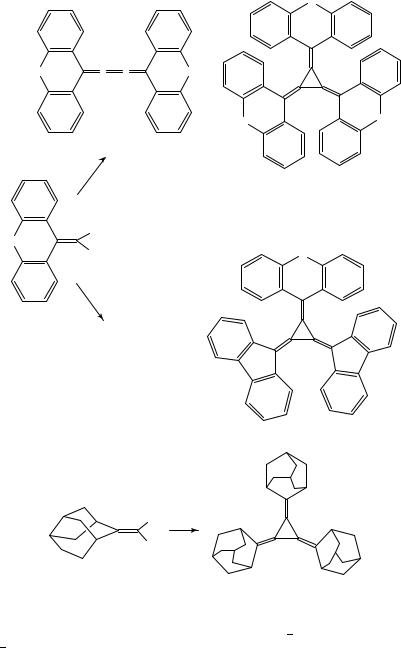
934 |
|
Gerhard Maas and Henning Hopf |
|
|
|
|
|
|
O |
O |
• |
• |
O + |
|
|
|
|
O |
O |
|
|
|
|
|
|
(31) 17% |
|
|
|
|
a |
|
|
(32) 2% |
|
50 °C |
|
|
|
|
Cl |
|
|
|
O |
Cl |
|
|
|
|
|
|
O |
|
+28 a
(31) 6% + (32) trace +
(33) 10%
Br
b
Br
(34) 54%
SCHEME 4. (continued)
with CuIÐPBu3 or CuBrÐMe2S gave the radialene in only 2 3% yield together with 28 (76 85%), and with CuCN only traces of 27 were found. Furthermore, decomposition of the cuprate obtained with CuIÐPBu3 in the presence of butatriene 28 did not result in an improved yield of 27 which suggests that the cumulene is not an intermediate in the radialene formation, in contrast to the lithium carbenoid pathway shown in Scheme 2.
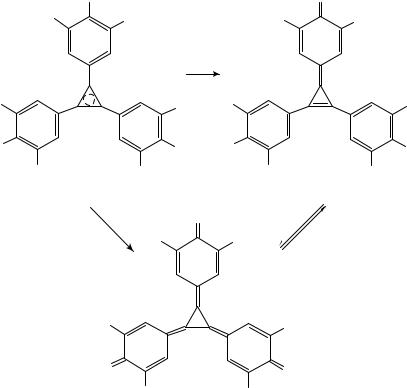
21. Synthesis and transformation of radialenes |
935 |
While no [4]- and [5]radialenes were formed in the decomposition of cuprate 26, the analogous cuprate generated from 1,1-dibromo-2,2-diphenylethene led to the corresponding [4]radialene, and [4]- and [5]radialenes were obtained from the cuprate derived from 22 (see Section II.B and II.C). These findings point to a steric influence on these cyclooligomerization reactions, with sterically demanding substituents favoring the formation of [3]radialenes.
The most recent strategy to prepare [3]radialenes is the treatment of 1,1-dihaloalkenes with activated nickel. Thus, the aryl-substituted [3]radialenes (Z,E,E)-30 and (E,E,E)- 30, 27 and 32 were obtained together with the corresponding butatrienes (29, 28, 31) from the 1,1-dibromo- or 1,1-dichloroalkenes with the help of nickel activated by ultrasound (Scheme 4)11. It is worth mentioning that the mixed-substituted radialene 33 was produced, when the nickel carbenoid derived from 9-(dichloromethylene)xanthene was generated in the presence of butatriene 2811.
Treatment of 2-(dibromomethylene)adamantane with Ni(0) generated from NiBr2- (PPh3)2, Zn and PPh3 in DMF gave the corresponding butatriene as the main product, but no tris(2-adamantylidene)cyclopropane 34. However, when the activated nickel was generated from NiI2 and Li powder with 4,40 -di-tert-butylbiphenyl as electron carrier
|
OH |
|
|
|
O |
R1 |
|
R1 |
|
R1 |
R1 |
|
|
|
Et3 N |
|
|
R2 |
+ |
R3 |
|
R2 |
R3 |
HO |
|
OH |
|
HO |
OH |
|
− |
|
|
||
AlCl4 |
R3 |
|
R2 |
R3 |
|
R2 |
|
|
|||
(35) |
|
|
|
(36) |
|
K3 Fe(CN)6 |
|
|
O |
K3 Fe(CN)6 |
|
|
|
or PbO2 |
|
||
|
|
|
|
||
KOH, H2O, benzene |
|
|
|
||
R1 |
|
R1 |
hydroquinone |
||
|
|
|
|||
|
|
|
|
|
|
|
R2 |
|
|
|
|
|
|
|
|
|
|
R3 |
|
|
|
|
|
|
|
|
||
|
|
|
|
|
|
|
|
O |
|
|
|
|
|
|
|
|
|
|
O |
|
|
|
|
|
|
|
|
|
|
|
|
|
|
|
|
|
|
|
|
|
|
|
|
|
|
|
|
|
|
|
|
|
|
|
|
||
|
|
|
|
|
|
|
|
|
|
R2 |
|
|
|
|
|
R3 |
|
|
|
|
|
|
|
|
|
|
|
|
|
|
|
|
|
|
|
|
|
|
|
|
|
|
(37) |
|
|
|
|
|
|
|
|
|
|
|
|
|
|
SCHEME 5. |
|
|
|
(a) R1 |
|
R2 |
R3 |
|
Me; (b) R1 |
|
R2 |
|
R3 |
|
i-Pr; (c) R1 |
|
R2 |
3 |
t |
|
||||||||
35 37: |
D |
D |
3D |
D |
D1 |
D |
-Bu; |
|||||||||||||||||||||
1 |
2 |
|
3 |
|
|
D 1 |
|
2 |
D t-Bu, R |
|
|
D i-Pr, R |
2 |
|
3 |
D R |
|
|||||||||||
(d) R |
D R |
D t-Bu, R |
|
D Me; (e) R |
D R |
|
D i-Pr; (f) R |
|
D R |
|
D t-Bu |
|
||||||||||||||||
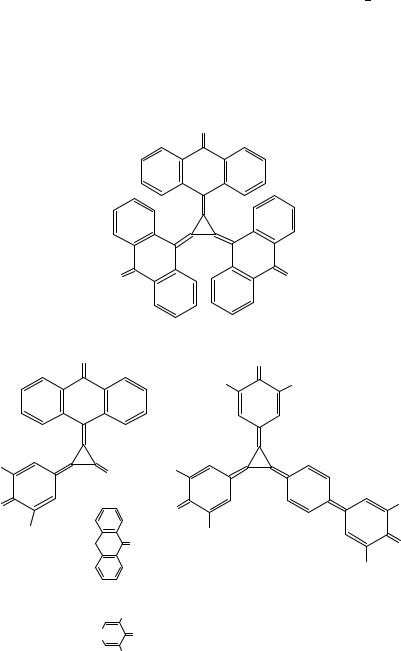
936 |
Gerhard Maas and Henning Hopf |
in THF, radialene 34 was the sole product in 54% isolated yield (Scheme 4)12. These results show that the success of the Ni(0)-mediated cyclotrimerization reactions depends on many factors, including the nickel activation, as well as electronic (cf 30a c; electronwithdrawing aryl substituents give better yields) and steric factors (successful formation of 34 as opposed to [4]- and [5]radialene formation from 1,1-dibromo-2-methylpropene, see Sections II.B and II.C).
A variety of functionalized [3]radialenes have been prepared starting from the appropriately substituted cyclopropanes or cyclopropenes. West and Zecher have pioneered the chemistry of [3]radialenes with quinoid substituents. The general strategy of this synthesis is outlined in Scheme 513. A tris(4-hydroxyphenyl)cyclopropenylium
O
O |
O |
(38) |
|
O |
O |
t-Bu |
Bu-t |
t-Bu |
|
X |
t-Bu |
|
|
|
|
||
O |
|
|
Bu-t |
|
|
|
O |
||
t-Bu |
X = |
|
t-Bu |
|
(39) |
O |
|||
O |
||||
|
|
|
t-Bu |
|
(9-anthron-10-ylidene) |
(41) |
|||
|
||||
|
|
Bu-t |
|
|
(40) |
X = C |
O |
|
|
|
|
Bu-t |
|
|
